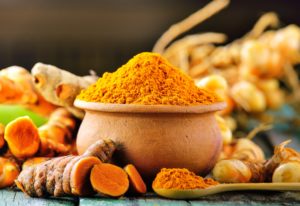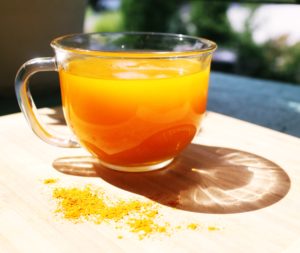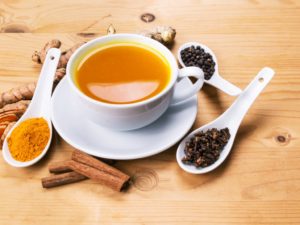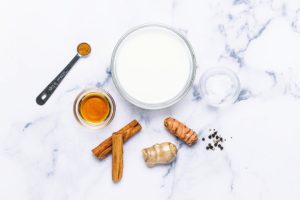[vc_row][vc_column][vc_column_text]Turmeric tea is a type of tea that originates from Okinawa, which is located in southern Japan. Turmeric itself is an herb that’s related to ginger, which is another spice well known for its healing properties, and is grown in Central America, Asia, and India. Turmeric has been in use for thousands of years as an integral part in Ayurvedic medicine.
Currently, turmeric is commonly used as a dietary supplement for health conditions such as pain, fatigue, and inflammation. It’s also a major ingredient in curry powder. In addition, it is widely used as a regular spice for foods.
The primary active ingredients contained in turmeric, which are curcuminoids, are yellow, which gives turmeric–and curry–its unique yellow color. Turmeric can also be made into a paste for skin conditions, and for use in golden milk, which is a beverage made using turmeric and milk. Many studies have been conducted to test turmeric’s ability to aid people with a wide variety of health conditions.
Using healing spices and herbs is an effective and unique way to support your overall wellness. There are many different options, from adding herbs to your food during meals, taking supplements, or sipping a wellness tea at night. There are many benefits these offer for us, and it’s easy to apply that knowledge to your everyday life. This is especially true if you turn to health coaches or dieticians, who can make it easier for you to incorporate these beneficial superfoods into your life, and experience all the benefits they have to offer in delicious ways.
Among many people, dieticians included, turmeric is a very popular and favorite healing food. Turmeric has a long, rich history of being used for medicinal reasons. Not only that, but it’s also incredibly versatile and there are many different ways you can use it in your kitchen. Turmeric tea is an ancient remedy that has been used for thousands of years. It definitely still holds its place in modern medicine and can be incorporated into your current self-care routine.
Related Article: Ginger Tea
What Exactly is Turmeric, and What Can It Be Used For?


The conditions that turmeric is commonly used for in an attempt to help heal and alleviate ailments include:
- Conditions that attack the joints, such as arthritis
- Inflammation and pain
- Hay fever
- Inflammatory conditions such as colitis
- General digestive discomfort
- Itchiness
- Depression
- Acne
- Glowing and healthy skin
- General support for the immune system
- General heart health, such as reducing free-radical damage and improving endothelial functioning, which is where turmeric’s antioxidants come in handy
Beyond general and common health conditions like acne, inflammation, and heart health, turmeric can also help in a myriad of ways with more specific treatments for ailments such as:
- Heartburn
- Crohn’s disease
- Stomach pain
- Diarrhea
- Ulcerative colitis
- Intestinal gas
- Loss of appetite
- Stomach bloating
- Liver problems
- Jaundice
- Irritable bowel syndrome (IBS)
- Stomach ulcers
- Skin inflammation from radiation treatment
- High cholesterol
- Fatigue as a symptom of other health conditions
- Bronchitis
- Headaches
- Lung infections
- Colds
- Fever
- Fibromyalgia
- Menstrual problems
- Dealing with cancer symptoms
- Recovery after surgery
- Alzheimer’s
- Water retention
- Diabetes
- Kidney problems
- Urinary bladder inflammation
As you can see, turmeric can be used for a variety of conditions. Although it is not necessarily a cure-all solution, turmeric can often help with almost anything you’re dealing with. Above all, turmeric is most well-known for its aid in inflammation.
Inflammation is the root cause of many health conditions such as cognitive decline, cancer, metabolic syndrome, and heart disease. Anti-inflammatory foods such as turmeric can really help you protect yourself against these ailments, as well as ease your symptoms if you already have them. Some studies have also looked at turmeric’s anti-aging potential. Really, you can’t go wrong if you have some turmeric in your cupboard.
Related Article: Are Potatoes Gluten Free?
What Form Can I Purchase Turmeric In?


Most clinical research studies have taken a look at turmeric extracts, since they have the most amount of healing properties. These studies have found that consuming ½ teaspoon to 1 teaspoon of turmeric powder, alongside food, per day is associated with many health benefits. Even a small amount daily can provide you with some benefits.
That said, however, it’s important to note that pregnant women should use caution, and you should have reservations if you have certain health conditions. In addition, be careful if you take certain medications, such as medication for diabetes or to thin your blood. In addition, circumin isn’t absorbed very well into your bloodstream, so it’s recommended that you consume it with black pepper, which will help to enhance your absorption thanks to pepper’s substance piperine.
What is Turmeric Tea?


Luckily, there’s an easy solution: turmeric tea. This tea makes it easy to sip a concoction that includes turmeric and incorporate it into your body. There’s also something quite soothing about tea, which makes the experience even better.
Turmeric tea has been in use for hundreds of years as an ancient Ayurvedic remedy that has been used to boost digestive health and skin health. Traditionally, turmeric tea will contain a little bit of black pepper so your absorption is enhanced, as well as a bit of ginger, which is another herb that contains powerful anti-inflammatory properties.
Many doctors prescribe medications as well as recommendations for herbs and spices to help you manage your variety of symptoms and health conditions. Turmeric tea is frequently recommended by health professionals, and once people decide to give it a try, their life–and the way they’re able to deal with their ailments–is changed. There’s a classic way to prepare turmeric tea, but you’ll find lots of variations, all of which are delicious and fun to try. For example, some recipes call for the addition of lemon juice, which gives you a boost of Vitamin C.
You can also enhance your turmeric tea with some green tea, which has commonly been associated with weight management, soothing properties, and improving mental alertness. Using matcha is a great way to boost yourself with even more antioxidants. Just keep in mind that matcha and other types of green tea contain caffeine, so you shouldn’t consume them before you go to bed.
Adding milk and creating a beverage that’s known as golden milk is another great way to incorporate turmeric into your life. Fat also enhances your absorption of curcumin, so adding coconut milk, almond milk, or dairy to your tea can help you enjoy all its healing benefits even more. Try it with steamed milk and a bit of sweetness such as honey. Traditionally, turmeric tea is prepared hot, but you’re welcome to try it cold as well.
When Should I Use Turmeric Tea?


- When you need to soothe your soul on a chilly day, or at night before you go to bed in order to get a better night’s sleep
- You’d like to get that healthy glow to your skin
- When you’re dealing with certain health issues, such as you’re suffering from a cold and you need a boost to your immune system; as soon as you feel a scratchy throat or can tell some symptoms are coming on, make a cup
- If you’re an athlete either looking to soothe the inflammation and pain you might feel because of your sport, or if you got injured and are looking to help repair your body
- If you consistently work out and enjoy physical activity, you can benefit from adding turmeric tea to your routine
- As a complement to physical therapy, yoga, and other ways of healing as you try to regain mobility and strength and ease any soreness
Many health care professionals recommend turmeric tea as a means to support your healing of joint conditions and other types of inflammatory issues throughout your body. If you’d like to take turmeric but tend to avoid supplements, turmeric tea every day in the evening is a great way to ensure you’re taking this healing herb every day. Just make sure you take time to enjoy your tea and sip it slowly rather than throwing it back as you’re heading out the door.
When Should I Avoid Using Turmeric Tea?


In general, regularly ingesting turmeric is very safe. However, you should avoid it if you:
- Are pregnant
- Have gallstones
- Have problems with your bile duct
- Have kidney stones or are at risk for them
- Have an iron deficiency or are prone to them, because turmeric can impair iron absorption
- Are on blood thinner medication, because curcumin can slow blood clotting
- Are on medication for diabetes, as turmeric may lower blood sugar
You also should take care to ingest turmeric in moderate amounts, as a very high intake of the herb can lead to gastrointestinal discomfort. If you’re thinking of trying out turmeric tea and you’re debating drinking it every once in a while, this is perfectly fine. However, if you’d like to start drinking turmeric tea every day, you need to check in with your doctor first and discuss how to use turmeric safely.
Related Article: Green Smoothie Recipe
Turmeric Tea Recipes


- Ingredients:
-
-
- 8 ounces of water
- 1 teaspoon ground turmeric
- ¼ teaspoon ground black pepper
- ¼ teaspoon ground ginger
-
- Preparation:
-
- Pour the water into a small saucepan and stir in the turmeric
- Bring this to a boil over medium heat. Let boil for five minutes, then remove from heat
- Add the ginger and black pepper. Stir well so all ingredients are incorporated
- Enjoy your tea in small sips
Take note that often, the spices separate and will float to the bottom of your cup. Simply give the drink a stir so each sip brings you beneficial properties.
An Important Ingredient in Golden Milk


Ayurveda is one of the oldest holistic medical practices in the world. It was developed in India over three thousand years ago, and it’s still currently used throughout the world as a powerful and sophisticated health system that focuses on the mind and body. It aims to not just to treat illness, but also, to help people as a science of life. The two guiding principles of Ayurveda are that the body and the mind are inextricably connected, and that nothing has more power to transform and heal your body than your mind.
Turmeric is definitely the star in golden milk, and provides the drink with its interesting yellow color, as well as its healing properties. The most significant compound within turmeric is curcumin, and this is what holds those medicinal properties. Many people around the world use turmeric and curcumin to alleviate arthritis, joint pain, and inflammation, and even as a means to treat depression, which is partially the reason why golden milk is so well known for being a soothing evening drink. Essentially, turmeric is a wellness rockstar and many people can find multiple benefits from drinking golden milk before heading to bed.
You don’t have to just make it at home, either–at certain retreats, resorts, and other hotel stays around the world, you’ll find you’re served golden milk every day as a part of your experience. Healthy cafes also offer it across the country, and you can easily purchase turmeric or find golden milk readily made at your local health food store. Golden milk is a simple way to treat yourself at night and give yourself a healthy nightcap, with its high antioxidant content and anti-inflammatory properties. Many people are discovering it’s a wonderful addition to their evening rituals. Of course, you can drink golden milk at any time of the day whenever you’d like to.
The key ingredients to soothing, healthy golden milk are:
- Ground turmeric powder. When you make golden milk, using ground powder is more beneficial than fresh turmeric root, because the powder is more concentrated.
- Ground black pepper. Black pepper is very prevalent in Ayurvedic medicine and is often used as an ingredient in order to increase the benefits of other ingredients, and help your body digest them better.
- Milk. You can make the choice whether to use traditional cow’s milk, or to use your favorite nut milk alternative; either is fine, and will provide a full, creamy texture.
- A small amount of fat. This makes your golden milk even creamier, and it’s easy to use healthy fat that will help you absorb all the beneficial ingredients. Choose something such as organic ghee, coconut oil, or almond oil.
Other ingredients that you can add to your golden milk for extra health benefits and even more flavor include spices and aromatics, such as:
- Ground or fresh ginger
- Ground cardamom
- Ground cinnamon
- Raw honey
- Vanilla extract, or in pods
How To Make Golden Milk


- Blend all ingredients into a pot, and allow it to simmer on the stove so the turmeric is cooked
- Create turmeric paste, and add this to spices and warmed milk as needed
The most important thing that you ensure is that the turmeric is fully cooked, and combined with a little bit of black pepper so that you increase your ability to absorb the curcumin. To make pure golden milk, you should also use cookware that is made from stainless steel materials. Avoid using the microwave to heat anything, or cookware that contains teflon or synthetic fluoropolymers such as PTFE. Whenever you can, use organic (or “clean”) ingredients, as the whole point to the drink is to help detox your body, provide health benefits, and give you anti-inflammatory benefits.
Keep in mind, golden milk is a treat for yourself that you can incorporate into a healing wellness regimen. It won’t be the same size as the Venti coffee you get from Starbucks. The traditional serving size of golden milk is just ¼-½ cup, and you should experiment a little to discover the perfect amount for yourself, so you get all the healing benefits but don’t overwhelm your digestive system.
Lots of people enjoy a little bit of sweetener with it, and a small amount of liquid stevia or raw honey will do the trick. Sweetener isn’t a traditional aspect of the drink, but it’s perfectly fine to use if you desire so, as long as you add it when the pan is off heat. Vanilla is a great way to sweeten your drink and add a little flavor, as well as cinnamon and ginger; it gives your drink wonderful flavor but won’t be too overpowering.
Recipes for Golden Milk


- Combine two parts purified water to one-part turmeric powder in a small saucepan (recommended: 3-4 tablespoons of turmeric powder and ½ cup water)
- Add a pinch of ground black pepper (recommended: ⅛ teaspoon)
- Simmer this over low heat, until it forms a paste-like consistency
- Watch it as it’s on the stove, until all the water is evaporated, and the paste has thickened; this should take about 15 minutes
The mixture can be stored in your refrigerator for up to two weeks. When you’re ready to use it, simply heat your milk on the stove. Once the milk is heated through, remove from heat and add the paste. You don’t have to measure it out exactly but take around ¼ teaspoon of turmeric paste to 1 cup of milk for a perfect combination. Add a dash of your desired sweeteners and spices, and you’re good to go.
You can also find many recipes on the internet for golden milk, such as this one for golden milk made with coconut milk, which makes two servings:
- Ingredients:
- 1 cup of organic coconut milk
- ½ teaspoon of ground turmeric, or ¼ teaspoon of your ready-made turmeric paste
- ¼ teaspoon of raw honey, once the mixture is taken off heat
- ¼ inch piece of ginger root, peeled and grated
- A pinch of pepper (if you’re using ground turmeric; leave out if you’re using your paste)
- A pinch of ground cardamom
- Method:
- Blend all ingredients, then warm on the stove
- Simmer (do not boil) for 15 minutes
- You can either blend the ingredients by hand, or use a quality blender if you’d like your drink to be frothier
And this one for golden milk made with almond milk, which creates two servings:
- Ingredients:
- 1 cup of almond milk
- ½ teaspoon of ground turmeric or ¼ teaspoon of turmeric paste
- 1-2 teaspoons of almond oil
- ¼ teaspoon of raw honey, added once mixture is taken off the heat
- ¼ inch piece of ginger root, peeled and grated
- A big pinch of ground black pepper if you’re using ground turmeric (leave out if you’ve made the paste)
- A big pinch of ground cardamom
- Method:
- Blend all ingredients, then warm on the stove
- Simmer (do not boil) for 15 minutes
- You can blend the ingredients by hand, or use a blender if you wish for a frothier drink
Making your own golden milk at home is simple and easy. Plus, it is a wonderful and beneficial addition to your nightly wellness routine.
Conclusion
Turmeric has already been in use for centuries. This herb, which is closely related to ginger, is part of an ancient Ayurvedic remedy that’s an excellent, healthful addition to your modern self-care routine. It’s easy to harness the powers of this healing herb, which is most well-known for its anti-inflammatory properties. Plus, it can help with a myriad of health ailments. Whatever you have, it’s likely turmeric can help. The herb is even recommended by many healthcare professionals throughout the world as a soothing, healthy way to deal with your ailments.
Two of the easiest and most convenient ways to incorporate turmeric into your daily life is to use it as an ingredient in turmeric tea and golden milk, which you can make every evening as part of your nightly wellness routine. If you’re a little hesitant and aren’t sure you’ll enjoy these beverages, keep in mind that you can try it once, and if you don’t like it, you don’t have to make it again. There are other ways to incorporate turmeric into your diet, such as taking supplements. Adding your favorite milk and sweeteners to your tea can be a great way to help yourself warm up to the taste of turmeric, if it’s a new experience for you.
You can enjoy the classic recipes for turmeric tea and golden milk, but you’re welcome to experience and make fun, delicious, healthy variations. Just be mindful that high doses of turmeric can be harmful, and you should avoid the herb if you are pregnant or taking certain medications. As with any addition to your wellness routine, you should check in and speak with your doctor beforehand to ensure you’re taking it safely.[/vc_column_text][/vc_column][/vc_row]
